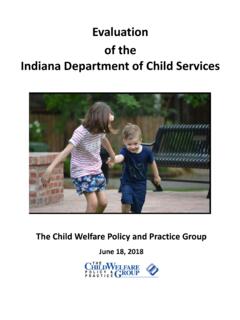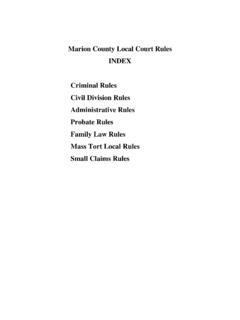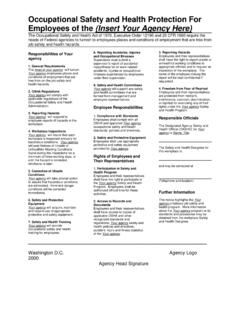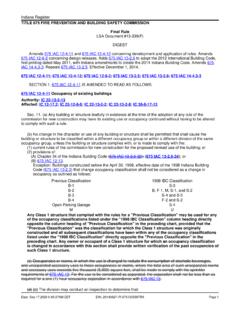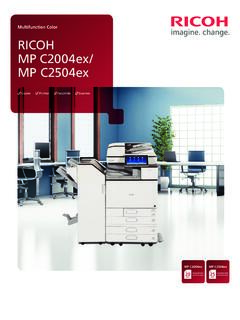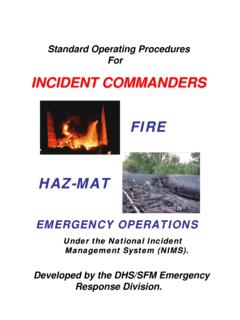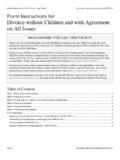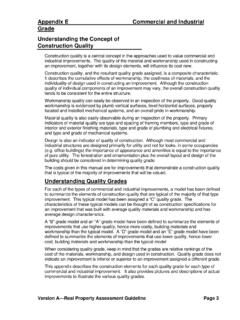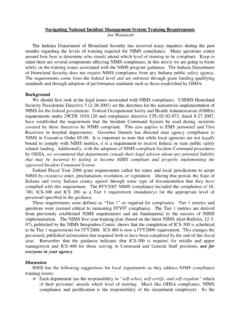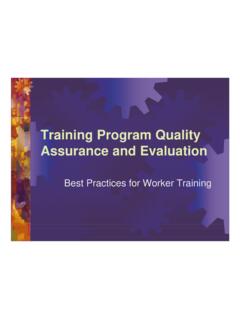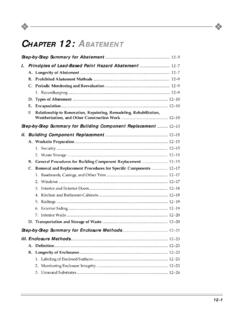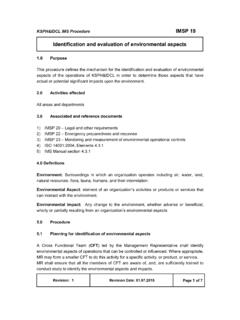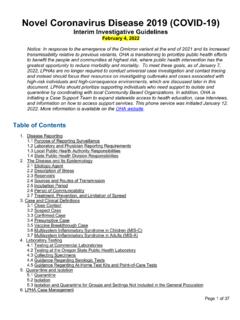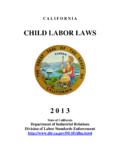Transcription of Sample Written Program - Indiana
1 Sample Written Program For Confined Space provided as a public service Indiana Department of Labor INSafe Division Occupational Safety and Health Consultation Program 2 Confined Space Program The following confined space Program is provided only as a guide to assist employers and employees in complying with the requirements of OSHA s Confined Space Standard, 29 CFR , as well as to provide other helpful information. It is not intended to supersede the requirements of the standard. An employer should review the standard for particular requirements that are applicable to their individual situation, and make adjustments to this Program that are specific to their company. An employer will need to add information relevant to their particular facility in order to develop an effective, comprehensive Program . 3 Confined Space Program Table of Contents I.
2 Objective II. Background III. Assignment of Responsibility A. Employer B. Program Manager C. Entry Supervisors D. Attendants E. Rescue Team F. Entrants/Affected Employees IV. Training A. Training Frequency B. General Training C. Specific Training D. Verification of Training V. Identification of Hazards and evaluation of Confined Spaces A. Survey B. Hazard Reevaluation C. Pre-Entry Hazard Assessment D. Hazard Controls VI. Entry Permits A. Key Elements of Entry Permits B. Permit Scope and Duration VII. Entry Procedures A. Prior to Entry B. Opening a Confined Space C. Atmospheric Testing D. Isolation and Lockout/Tagout Safeguards E. Ingress/Egress Safeguards F. Warning Signs and Symbols VIII. Emergency Response A. Emergency Response Plan B. Retrieval Systems and Methods of Non-Entry Rescue IX. Attachment, Sample Process Duty Roster 4 Confined Space Program For Company Name I. OBJECTIVE The purpose of Company Name s Confined Space Program is to set procedures that will ensure workers safe entry into confined spaces and permit-required confined spaces to perform routine tasks associated with their employment.
3 This procedure is designed to provide the minimum safety requirements in accordance with the Occupational Safety and Health Administration s (OSHA) Confined Space Standard, II. BACKGROUND A confined space is defined as any location that has limited openings for entry and egress, is not intended for continuous employee occupancy, and is so enclosed that natural ventilation may not reduce air contaminants to levels below the threshold limit value (TLV). Examples of confined spaces include: manholes, stacks, pipes, storage tanks, trailers, tank cars, pits, sumps, hoppers, and bins. Entry into confined spaces without proper precautions could result in injury, impairment, or death due to: A. an atmosphere that is flammable or explosive; B. lack of sufficient oxygen to support life; C. contact with or inhalation of toxic materials; or D. general safety or work area hazards such as steam or high pressure materials. III.
4 ASSIGNMENT OF RESPONSIBILITY A. Employer In administering this Confined Space Program , Company Name will: 1. Monitor the effectiveness of the Program . 2. Provide atmospheric testing and equipment as needed. 3. Provide personal protective equipment as needed. 4. Provide training to affected employees and supervisors. 5. Provide technical assistance as needed. 6. Preview and update the Program on at least an annual basis or as needed. B. Program Manager Responsible Person is responsible for managing the Confined Space Program , and shall: 5 1. Ensure that a list of confined spaces at all Company Name worksites is maintained. 2. Ensure that canceled permits are reviewed for lessons learned. 3. Ensure training of personnel is conducted and documented. 4. Coordinate with outside responders. 5. Ensure that equipment is in compliance with standards. 6. Ensure that the Responsible Person in charge of confined space work shall: a.
5 Ensure requirements for entry have been completed before entry is authorized. b. Ensure confined space monitoring is performed by personnel qualified and trained in confined space entry procedures. c. Ensure a list of monitoring equipment and personnel qualified to operate the equipment is maintained by the Safety and Occupational Health Office. d. Ensure that the rescue team has simulated a rescue in a confined space within the past twelve (12) months. e. Know the hazards that may be faced during entry, including the mode (how the contaminant gets into the body), signs or symptoms, and consequences of exposure. f. Fill out a permit. g. Determine the entry requirements. h. Require a permit review and signature from the authorized Entry Supervisor. i. Notify all involved employees of the permit requirements. j. Post the permit in a conspicuous location near the job. k. Renew the permit or have it reissued as needed (a new permit is required every shift).
6 L. Determine the number of Attendants required to perform the work. m. Ensure all Attendant(s) know how to communicate with the entrants and how to obtain assistance. n. Post any required barriers and signs. o. Remain alert to changing conditions that might affect the conditions of the permits ( , require additional atmospheric monitoring or changes in personal protective equipment). p. Change and reissue the permit, or issue a new permit as necessary. q. Ensure periodic atmospheric monitoring is done according to permit requirements. r. Ensure that personnel doing the work and all support personnel adhere to permit requirements. s. Ensure the permit is canceled with the work is done. t. Ensure the confined space is safely closed and all workers are cleared from the area. 6 C. Entry Supervisors Responsible Person(s) shall serve as the Entry Supervisor(s), and shall be qualified and authorized to approved confined space entry permits.
7 The Entry Supervisor(s) shall be responsible for: 1. Determining if conditions are acceptable for entry. 2. Authorizing entry and overseeing entry operations. 3. Terminating entry procedures as required. 4. Serving as an Attendant, as long as the person is trained and equipped appropriately for that role. 5. Ensuring measures are in place to keep unauthorized personnel clear of the area. 6. Checking the work at least twice a shift to verify and document permit requirements are being observed (more frequent checks shall be made if operations or conditions are anticipated that could affect permit requirements). 7. Ensuring that necessary information on chemical hazards is kept at the worksite for the employees or rescue team. 8. Ensuring a rescue team is available and instructed in their rescue duties ( , an onsite team or a prearranged outside rescue service). 9. Ensuring the rescue team members have current certification in first aid and cardiopulmonary resuscitation (CPR).
8 D. Attendants Responsible Person(s) shall function as an Attendant(s) and shall be stationed outside of the confined workspace. The Attendant(s) shall: 1. Be knowledgeable of, and be able to recognize potential confined space hazards. 2. Maintain a sign-in/sign-out log with a count of all persons in the confined space, and ensure all entrants sign in and out. 3. Monitor surrounding activities to ensure the safety of personnel. 4. Maintain effective and continuous communication with personnel during confined space entry, work, and exit. 5. Order personnel to evacuate the confined space if he/she: a. observes a condition which is not allowed on the entry permit; b. notices the entrants acting strangely, possibly as a result of exposure to hazardous substances; c. notices a situation outside the confined space which could endanger personnel; d. notices a hazard within the confined space that has not been previously recognized or taken into consideration; 7 e.
9 Must leave his/her work station; or f. must focus attention on the rescue of personnel in some other confined space that he/she is monitoring . 6. Immediately summon the Rescue Team if crew rescue becomes necessary. 7. Keep unauthorized persons out of the confined space, order them out, or notify authorized personnel of an unauthorized entry. E. Rescue Team The Rescue Team members shall: 1. Complete a training drill using mannequins or personnel in a simulation of the confined space prior to the issuance of an entry permit for any confined space and at least annually thereafter. 2. Respond immediately to rescue calls from the Attendant or any other person recognizing a need for rescue from the confined space. 3. In addition to emergency response training, receive the same training as that required of the authorized entrants. 4. Have current certification in first aid and CPR. F. Entrants/Affected Employees Employees who are granted permission to enter a confined space shall: 1.
10 Read and observe the entry permit requirements. 2. Remain alert to the hazards that could be encountered while in the confined space. 3. Properly use the personal protective equipment that is required by the permit. 4. Immediately exit the confined space when: a. they are ordered to do so by an authorized person; b. they notice or recognize signs or symptoms of exposure; c. a prohibited condition exists; or d. the automatic alarm system sounds. 5. Alert Attendant(s) when a prohibited condition exists and/or when warning signs or symptoms of exposure exist. IV. TRAINING Company Name shall provide training so that all employees whose work is regulated by this Confined Space Program acquire the understanding, knowledge, and skills necessary for the safe performance of their duties in confined spaces. 8 A. Training Frequency Responsible Person shall provide training to each affected employee: 1. before the employee is first assigned duties within a confined space; 2.

